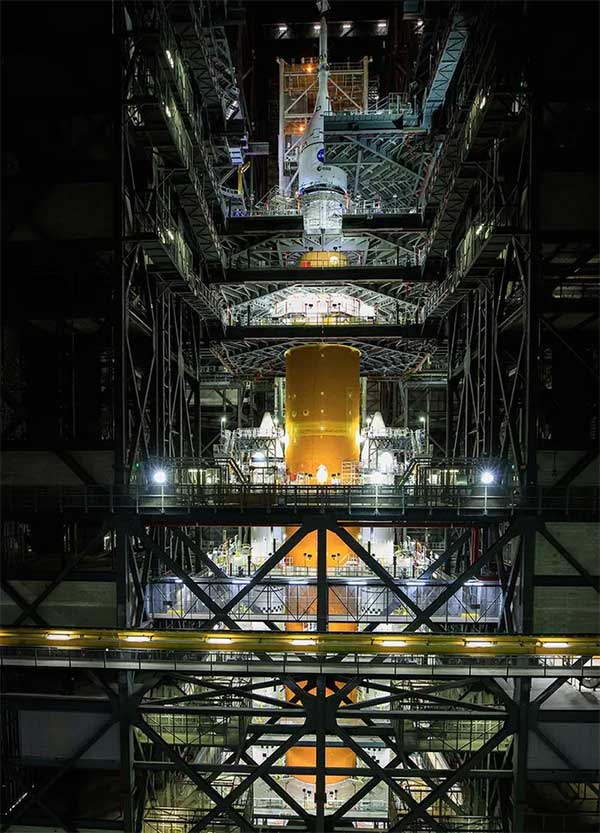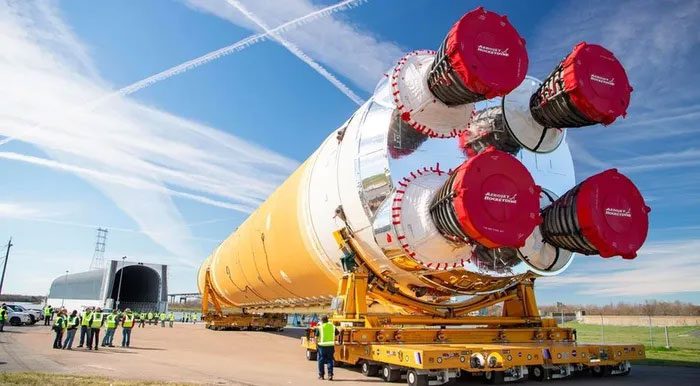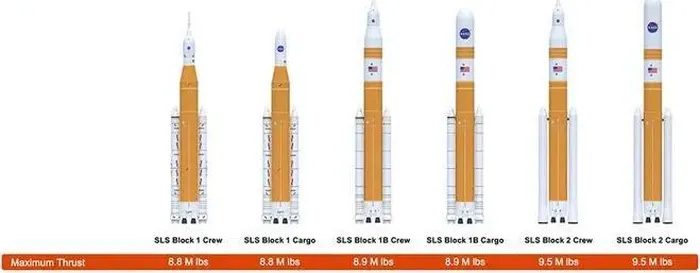The event of the U.S. launching the SLS super rocket is approaching. It is expected that hundreds of thousands will witness this historic moment.
The SLS super rocket, the most powerful rocket in NASA’s history, is set to carry out its first mission at the end of August 2022 – marking the beginning of a new era called Artemis: Exploring the Moon in the 21st Century.
The Space Launch System (SLS) – also referred to by NASA as the Mega Moon – stands 98 meters tall and is the strongest rocket ever built by NASA.
The SLS will launch from the pad with a thrust of 4,450 tons – a power greater than 15% compared to the legendary Saturn V rocket from the Apollo era and nearly 12% more powerful than the system that launched the U.S. Space Shuttle into orbit.
“A feast for all the senses”
According to NASA, the SLS rocket’s Artemis I mission (the rocket’s first launch) is scheduled for August 29, 2022, at 8:33 AM Eastern Time (ET).
Setting aside the records that the SLS might set after the Artemis I mission, observers note that the official launch of the SLS into space will attract tens, even hundreds of thousands of people to enjoy this ‘feast for all the senses.’

The SLS super rocket and the Orion spacecraft (in white) stacked together in the Vehicle Assembly Building at Kennedy Space Center in Florida, USA. (Photo: NASA)
A local tourism official told Florida Today that more than 100,000 visitors are expected to come to Florida’s Space Coast to witness (from a distance) the 2,875-ton rocket launch from Launch Pad 39B at Kennedy Space Center, carrying the Orion spacecraft on a 42-day journey around the Moon and back to Earth.
A successful SLS launch will mark the beginning of the Artemis era and may pave the way for a crewed mission (named Artemis II) in 2023, all aimed at ‘clearing the path’ for the even more critical Artemis III mission: returning humans to the Moon in 2025.
Space Coast is no stranger to large crowds. During the Shuttle era, it was common for half a million people to gather to witness a U.S. space launch, and as Peter Cranis, Executive Director of the Space Coast Tourism Office, told Florida Today, SpaceX’s Crew Dragon launches are attracting up to 250,000 visitors. Therefore, the expected 100,000 attendees for the SLS launch could very well increase.
Florida Today reported that there are only about 10,000 hotel rooms and 4,500 rental units in Brevard County, indicating that many visitors from surrounding areas, such as from Orlando, will not be staying overnight.
For tourists, Space Coast is truly ‘living’ up to its name. Besides beautiful beaches, this stretch of the Atlantic coast is currently witnessing a series of regular rocket launches. In 2022 alone, there have been 32 launches from Kennedy Space Center and Cape Canaveral – a frequency not seen since the 1960s.
Visitors can view these launches from the beach, in designated areas near the launch pad, and even from a rooftop bar of a nearby building.
SLS: “A technological marvel” that continues to evolve
The NASA Space Launch System is a super heavy-lift launch vehicle that provides a platform for human exploration beyond Earth’s orbit. With unprecedented power and capability, the SLS is the only rocket that can send the Orion spacecraft, astronauts, and cargo directly to the Moon in a single launch.
So far, the SLS is the rocket capable of carrying more payload into deep space than any other vehicle in the world.
The SLS will deliver the Orion spacecraft and other cargo to the Moon – nearly 1,000 times farther than where the International Space Station (ISS) orbits in Low Earth Orbit (LEO). After leaving the launch pad, the SLS will provide ‘monster’ power to help Orion reach speeds of 39,428 km/h – the speed necessary to get Orion to the Moon.
Seen as the launch vehicle for the Artemis era, the SLS is designed to evolve, enabling it to perform a wider variety of missions, including human missions to the Moon and Mars, as well as robotic science missions to places like the Moon, Mars, Saturn, and Jupiter.
To meet America’s future needs for deep space missions, SLS will evolve into increasingly powerful configurations. Every SLS configuration utilizes a core stage with 4 RS-25 engines.

The core stage of the SLS rocket being transported to Stennis Space Center for testing. (Source: NASA)
Boeing is responsible for building the core stages of the SLS, including avionics systems that control the vehicle during flight. Standing over 65 meters tall with a diameter of 8.4 meters, the core stage of the SLS houses two massive fuel tanks connected together: one tank containing 891,033 liters of super-cooled liquid oxygen; and a larger second tank containing 2,441,250 liters of liquid hydrogen – to fuel the RS-25 engines.
The SLS core stages are built at NASA’s Michoud Assembly Facility in New Orleans using advanced manufacturing equipment, including the largest friction stir welding tool in the world.
With the core stage for the Artemis mission completed, Boeing is now building core stages for subsequent Artemis missions.

Configurations of the SLS rocket are continuously improved to enhance crew and cargo capabilities for deep space as well as varying thrust. (Source: NASA)
Block 1
The first SLS vehicle, known as the Block 1 configuration, can send over 27 tons to lunar orbit.
Block 1 is equipped with two 5-segment solid rocket boosters and 4 RS-25 liquid engines. Once in space, the Interim Cryogenic Propulsion Stage (ICPS) of the SLS will take Orion to the Moon. The first three Artemis missions (Artemis I, II, III) will all utilize the Block 1 configuration with ICPS.
Block 1B
The SLS Block 1B rocket configuration will use a new, more powerful exploration vehicle called the Exploration Upper Stage (EUS) to undertake more ambitious missions.
The EUS is powered by 4 RL10C-3 engines that generate nearly 4 times the thrust of an RL10B-2 engine that powers the ICPS.
The Block 1B vehicle can carry the Orion crew along with large cargo for the systems required to support a long-term presence on the Moon in a single launch. Specifically, Block 1B can deliver 38 tons into deep space, NASA reports.
Block 2
The next SLS configuration, Block 2, will provide a staggering thrust of 4,750 tons; and will be the vehicle to transport cargo to the Moon, Mars, and other deep space destinations.
The SLS Block 2 will be designed to deliver over 46 tons into deep space. This is a ‘technological marvel’ that can help the U.S. lead new human and robotic space exploration missions.
NASA states that the SLS is an American rocket with contributions from over 1,100 companies across the country, and every NASA center is collaborating to support the development of the world’s most powerful launch vehicle.
The SLS program, managed by Marshall, works closely with the Orion Program managed by NASA’s Johnson Space Center; and the Exploration Ground Systems program, managed at Kennedy Space Center.
It can be said that the SLS is a massive launch platform for the U.S. to conduct deep space missions; helping the U.S. reaffirm its status as a superpower in space exploration worldwide.





















































